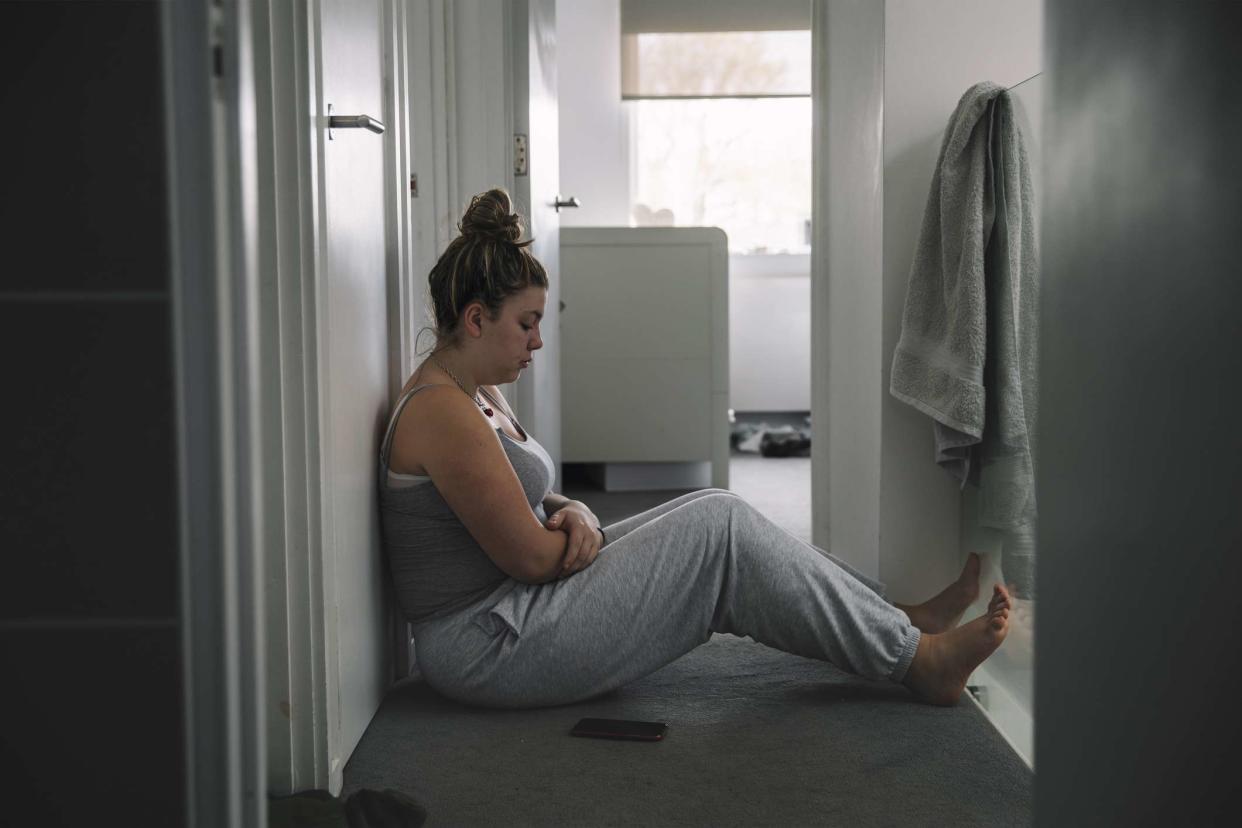Insulin Overdose: Signs, Symptoms, and Complications

Justin Paget / Getty Images
Medically reviewed by Danielle Weiss, MD
Insulin dosing is a multistep process that often requires adjustments based on meals, activity, insulin action time, and blood sugar levels. Sometimes people can take too much insulin and, as a result, their blood sugar drops. This is referred to as an insulin reaction or overdose.
Learn more about the symptoms of insulin overdose, including rare symptoms, vulnerable subgroups, and complications.

Justin Paget / Getty Images
Symptoms
Insulin, a hormone produced by the pancreas, plays a major role in blood sugar regulation. One of its primary jobs is taking up sugar from the bloodstream into the cells so the body can use it for energy.
People who have diabetes are often prescribed insulin, either because their cells are resistant to the insulin they are making, they are not making enough, or a combination of both.
The definition of overdose is when someone takes more than the recommended amount of medication or more than normal. When managing diabetes, it can be easy to miscalculate insulin doses and accidentally take too much.
The amount of excess insulin you took, the time of your last meal, your blood sugar level, and how much insulin you already have in your system will impact your reaction to the extra insulin.
Usually, when taking too much insulin, you will experience low blood sugar. This acute (sudden, short-term) complication can be corrected quickly with fast-acting carbohydrates. However, intentional insulin overdose is extremely dangerous and can lead to severe brain damage, coma, and death.
Taking too much insulin can result in low blood sugar (hypoglycemia). Everyone experiences hypoglycemia differently and should learn to identify their unique symptoms. According to the American Diabetes Association, symptoms of low blood sugar include:
Shakiness
Feeling nervous or anxious
Sweating, chills, and clamminess
Irritability or impatience
Confusion
Fast heartbeat
Feeling light-headed or dizzy
Hunger
Nausea
Pale skin
Feeling fatigued, sleepy, or tired
Feeling weak or having no energy
Blurred/impaired vision
Tingling or numbness in the lips, tongue, or cheeks
Headaches
Coordination problems, clumsiness
Nightmares or crying out during sleep
When hypoglycemia begins, the body releases epinephrine, the fight-or-flight hormone, which can cause a rapid heartbeat and sweating. As hypoglycemia progresses, the brain becomes starved of glucose (sugar), and as a result, you may experience blurred vision, difficulty focusing, confusion, slurred speech, drowsiness, and numbness.
Typically these symptoms come on quickly. The best way to confirm that your blood sugar is low is to check it and then treat it promptly. However, if you cannot test, you should still treat for low blood sugar.
Related:How Hypoglycemia Is Treated
In severe instances, when large doses of insulin are administered, or there is a delay in treating low blood sugar, hypoglycemia can cause rare symptoms, such as:
Seizures
Coma
Death
These are emergency situations in which 911 should be called and glucagon needs to be administered. Glucagon is used to treat severe hypoglycemia.
Complications/Subgroup Indications
Specific groups of people are at increased risk of experiencing an insulin overdose. These include children with type 1 diabetes, older people who take insulin, and people who have diabetes and depression.
Children
Children with type 1 diabetes who take insulin are at increased risk of developing hypoglycemia. Insulin action time, accurate carbohydrate counting, insulin sensitivity, hormones, and physical activity are all factors that can increase the risk of low blood sugar.
Anytime an insulin dose exceeds a need, a child is at risk of developing low blood sugar. For example, this can happen if a dose of insulin was given and a child did not finish their food, or the carbohydrates in the meal were not calculated accurately.
One of the main goals of care in treating kids with type 1 diabetes is hypoglycemia prevention because continued episodes of low blood sugar can increase the risk of neurological problems. Many children cannot communicate or alert a parent if they feel their blood sugar has dropped, which can complicate matters more.
The inability to identify hypoglycemia, along with age, recurrent hypoglycemia, and nighttime hypoglycemia, put children at risk for severe hypoglycemia. However, new technology, such as continuous glucose monitors, hybrid closed-loop systems, and sensor-augmented insulin pumps, have reduced the risk of severe hypoglycemia.
Parents and children must be educated on the signs and symptoms of low blood sugar and their child's blood glucose targets. It is also important to always carry and stock up on fast-acting carbohydrates, such as juice, glucose tablets, and glucose gel, so you're able to treat low blood sugar promptly.
If you feel like you are doing everything right, yet your child is still experiencing low blood sugar, contact your medical team. They may need to adjust their insulin doses to prevent overdosing.
Older Adults
Older adults often have other medical conditions and self-care obstacles, making dosing insulin more challenging. Problems with eyesight and dexterity can make insulin dosing difficult. Effective insulin dosing requires intact visual, motor, and cognitive abilities.
If a person has cognitive impairment or depression, self-care will become much more challenging. They may forget when they delivered their last dose of insulin, they may take insulin without eating enough food, they may not store the insulin properly, or they may administer it incorrectly.
Older people with diabetes are also at increased risk of hypoglycemia unawareness, which can increase the risk of severe hypoglycemia.
Hypoglycemia in older people can produce altered mental status, seizures, loss of consciousness, and arrhythmia (irregular heartbeat). It is also associated with falls that lead to fractures and, in severe instances, death.
To prevent low blood sugar and insulin dosing issues, older people taking insulin should be educated by a certified diabetes care and education specialist to screen for risk of hypoglycemia and dosing technique. When possible, alternative medications may be recommended, and glucose targets may need to be changed.
Diabetes and Depression
People with diabetes are more likely than people in the general population to have depression. Depression can cause problems with self-care and adherence to medication routines.
According to research, large numbers of people with diabetes go to the emergency room each year with low blood sugar that is "of unknown etiology." It is suspected that some visits result from an intentional insulin overdose. However, most of the literature is based on case studies instead of larger published data.
Intentional insulin overdose can cause severe side effects, including hypoglycemic encephalopathy, cerebral defects, and death. If you are a concerned caregiver, contact your medical team for help. They can assist you in seeking a mental health provider and in simplifying youe diabetes treatment plan (if it is the cause of depressive feelings).
If you are having suicidal thoughts, contact the 988 Suicide & Crisis Lifeline at 988 for support and assistance from a trained counselor. If you or a loved one is in immediate danger, call 911.
For more mental health resources, see our National Helpline Database.
When to See a Provider or Go to the Hospital
If you are having frequent bouts of low blood sugar despite dosing your insulin accurately, you should follow up with your healthcare provider to assess your insulin requirements. Doses of insulin may need to be changed from time to time, such as if you have become increasingly active or have lost weight. These types of changes can increase insulin sensitivity.
If you've taken too much insulin and have confirmed a low blood sugar reading, treat it with the rule of 15. Ingest 15 grams of fast-acting carbohydrates and retest your blood in 15 minutes to see if it has risen.
Depending on how low your blood sugar was and how much insulin you took, you may need to repeat these steps if your blood sugar has not increased. If your blood sugar is not rising to a normal range of 70 milligrams per deciliter (mg/dL), call your healthcare team to see what to do next.
Severe hypoglycemia means your blood sugar is too low to treat with fast-acting carbohydrates, and you cannot treat yourself. When this occurs, you need someone to give you glucagon. Glucagon is a hormone produced in the pancreas that stimulates the body to release stored glucose. If the person with diabetes is unconscious or you don't know how to use glucagon, call 911.
People with diabetes who take insulin should have a prescription for either injectable glucagon or inhaled glucagon. In the event of a severe low-blood-sugar emergency, glucagon must be administered. Talk to your healthcare team about glucagon.
Summary
An insulin overdose can occur when you deliver more insulin than is needed, which can sometimes happen in people with diabetes who take insulin. Taking too much insulin can result in low blood sugar, which should be treated promptly to prevent a hypoglycemic event.
If you have diabetes or are a caregiver to someone who has diabetes, understanding glucose targets, how the patient responds to insulin, and insulin delivery methods are important in preventing an overdose.

